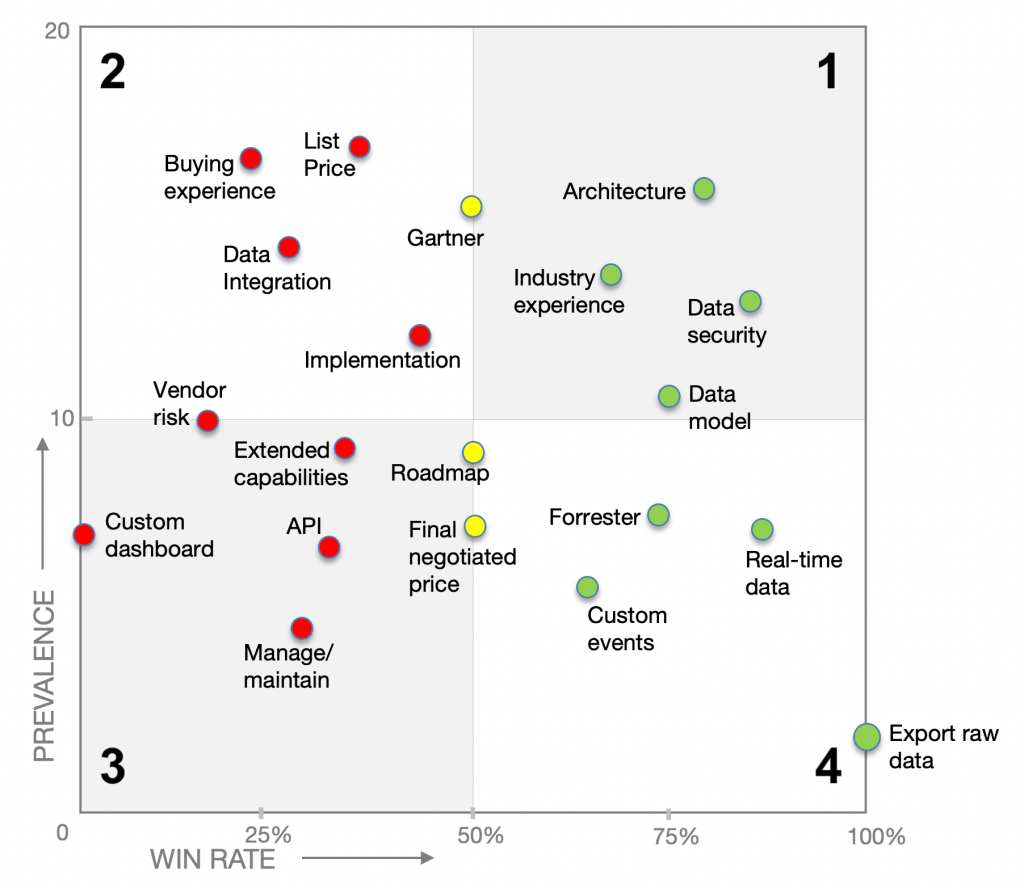In the early days of my career as a B2B product manager, I found it tricky to navigate the relationship with our sales team.
Joining sales calls to meet with prospective buyers or help out with a demo was fun and interesting.
But feature requests. I found these tough to handle, especially when a large deal was at risk. Marty Cagan calls these “specials” and recommends product managers just say no. ProductPlan advises a more nuanced approach to what they call “dealbreakers” and explain that with a flow chart.
While I eventually learned how to handle the individual feature requests, I remained puzzled by a bigger issue.
How can product holistically understand prospective buyers and incorporate that learning into our roadmap, to stay aligned with sales?
My responsibility was to win in the overall market, not just the one big deal with specials attached to it. I needed a way to align with sales on which product capabilities it’d take to win the overall market.
Align With Sales About ICP Needs, Not The Needs Of An Individual Buyer
To answer a buyer’s feature request, I needed to know how many other buyers agreed this enhancement was a must-have.
Put another way, how many sales opportunities had we lost because of this gap? How many prospects had found this same gap and moved on to a competing alternative for that reason? And how did this enhancement rank relative to all the other requests that were causing lost sales?
I had to know these things because I could commit to just the highest priority requests. After all, product management must also prioritize bug fixes and feature enhancement requests from existing customers and their advocates in Customer Success. As net dollar retention makes clear, the revenue from existing customers will always be greater than this quarter’s wins, once you’re past the earliest days. Our roadmap also needed to account for the priorities of Business Development, Professional Services or SIs, and others.
A Four Step Process For Understanding Prospective Buyers And Incorporating That Learning Into The Roadmap
Fast forwarding from my product management years to today, I’ve experienced firsthand how product and sales can use Win/Loss Analysis (good definition here) to align on roadmap priorities. (I’m the founder of Growth Velocity.)
At a high level, our win loss analysis service follows this same four-step process:
-
- Interview or survey buyers about the top criteria they used to short list and then select a provider.
- Calculate how many opportunities used each criterion in their selection decision.
- Calculate a win rate for individual criterion.
- Map each criterion, with prevalence as the y-axis coordinate. And win rate as the x-axis coordinate.
I’ll use the anonymized quadrant below to explain what happens next.

With the big picture view this quadrant provides, we now know which criteria are most prevalent and how each of them is affecting deal outcomes.
Now we can make more informed decisions:
Quadrant 1. These relatively common, high win rate criteria are driving our wins. We recommend that product marketing make these criteria the pillars of the value proposition. They’re important to many buyers and differentiate us. We should evangelize their importance in our messaging, content marketing, and sales tools. For the roadmap, we advise investing to maintain or even expand the lead in each of these areas.
Quadrant 2. These prevalent, low win rate criteria are driving our losses. We learn from the buyer feedback why buyers assess us poorly on these criteria, and how they find competing alternatives better. In parallel, we use the win interviews to learn how some buyers (our wins) overcame these concerns to move ahead with us. We recommend using this insight to update demos, RFI responses, sales training, and sales tools. Our goal is to better communicate how the solution meets buyer needs, until or instead of a product enhancement. For the roadmap, we now know two things. How buyers find us falling short of competing alternatives on each of these criteria. And that product management should prioritize these enhancements.
Quadrant 3. Here our win rate is low, but these criteria affect relatively few decisions. They’re relatively uncommon. Unless there’s a strategic interest in one of them, it’s hard to make a case for investing product or marketing resources here.
Quadrant 4. Our win rate on the criteria in this quadrant is high, but too few buyers are considering them in their selection decisions. To tilt decisions in our favor, we need to stimulate buyer consideration of these criteria. We want to pull these criteria into Quadrant 1. We advise clients to use webinars, decision guides, and sales tools and training to explain their importance to good selection decisions.
Other Data-Driven Approaches To Sales-Product Alignment
Win/Loss Analysis isn’t the only option for data-driven alignment between sales and product management. The CRM, win interviews, industry analysts, and lost deal reviews are all used to inform the roadmap. Their pros and cons, as I see it:
- The CRM is an enticing prospect. For a macro view of your GTM, it can’t be beat. The CRM contains data about every one of your opportunities. But in my experience most CRM implementations are contaminated with bad data. This can be overcome with rep training and enforcement. The leader of the CI program at a large enterprise technology vendor told me “it was a very painful process to get there” but they’re now having real success: they close deals 14-20 days sooner, and their deals are 25-50% larger.
- The analysts at Gartner, Forrester, and IDC work with both technology buyers and providers. So they have an informed perspective on buyer decision criteria and the capabilities of software providers in your category. Their advice won’t be based on a cohort of your buyers, unless you contract with them for win/loss analysis services.
- Review sites like Gartner Peer Insights and G2 collect feedback from a large mass of buyers and users. Since this feedback comes from actual product users, this seems a useful input to roadmap planning. However, it omits the perspective of buyers from lost deals.
- Win interviews also omit the perspective of buyers from lost deals. If our goal is to make roadmap decisions that support improved sales outcomes, we need to know which gaps are driving losses.
- Lost deal reviews can be a powerful tool for sales teams to learn from recent losses. But because sellers not buyers are the data source, and the sample sizes are small, they aren’t a reliable source for roadmap decisions.
Win-Loss Analysis Is The Best Way To Get Product And Sales Aligned On The Roadmap
The buyers of today are unlikely to have the same needs and priorities as the buyers of even a year or two ago.
Yet, product management often lacks a rigorous program for collecting and incorporating feedback from recent buyers into the roadmap. So we’re challenged to align with sales on the capabilities needed to win in the overall market.
Win/loss buyer interviews and win/loss surveys provide the big picture view that product managers need to make good roadmap decisions.
When product management has the data and analysis to stay aligned with sales on the product roadmap, they are less likely to be surprised by a dropoff in product-market fit and competitive losses.
Check our post “How To Conduct A Win/Loss Analysis” for step-by-step guidance on setting up your own program.
A Win/Loss Analysis You Can Actually Act On
Related Posts
Sales Win Loss Analysis: Why Data-Driven Leaders Are Leveling Up
Sales win loss analysis helps leaders make data-driven decisions. What’s working and where can we double-down? What isn’t working, and how do we fix it?
Win/Loss Analysis Reports: 3 Things You’ll Learn
Which aspects of your product offering and buying experience are helping drive sales? And which aspects are hindering sales? This is what enterprise and mid-market software companies often struggle to understand. A good win/loss analysis report will provide the answers to these questions.
Three Reasons Sales Leaders Want Even More Data About Their Buyers
While B2B sales teams are literally swimming in data, it’s not enough. Data-driven sales leaders are using input directly from buyers to find new ways to improve win rate and lead with conviction.




